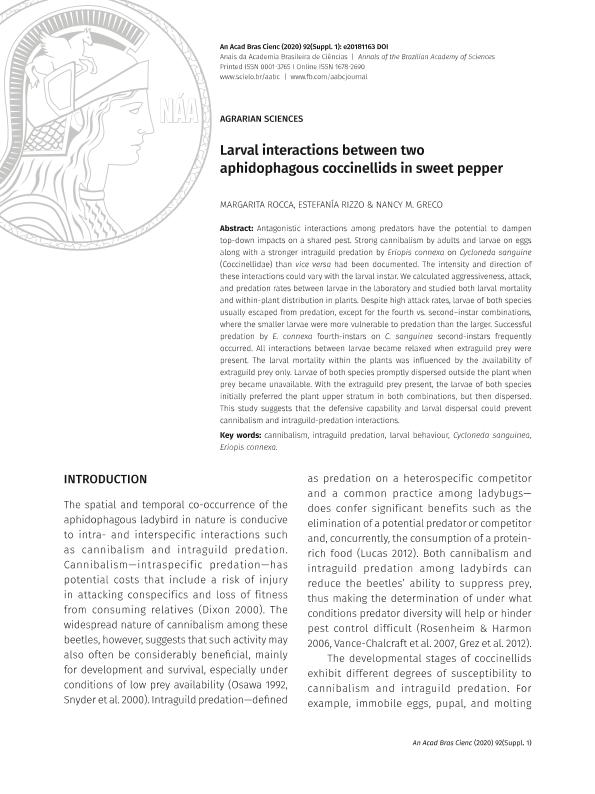Artículo
Larval interactions between two aphidophagous coccinellids in sweet pepper
Fecha de publicación:
07/2020
Editorial:
Academia Brasileira de Ciencias
Revista:
Anais da Academia Brasileira de Ciencias
ISSN:
0001-3765
e-ISSN:
1678-2690
Idioma:
Inglés
Tipo de recurso:
Artículo publicado
Clasificación temática:
Resumen
Antagonistic interactions among predators have the potential to dampen top-down impacts on a shared pest. Strong cannibalism by adults and larvae on eggs along with a stronger intraguild predation by Eriopis connexa on Cycloneda sanguinea (Coccinellidae) than vice versa had been documented. The intensity and direction of these interactions could vary with the larval instar. We calculated aggressiveness, attack, and predation rates between larvae in the laboratory and studied both larval mortality and within-plant distribution in plants. Despite high attack rates, larvae of both species usually escaped from predation, except for the fourth vs. second–instar combinations, where the smaller larvae were more vulnerable to predation than the larger. Successful predation by E. connexa fourth-instars on C. sanguinea second-instars frequently occurred. All interactions between larvae became relaxed when extraguild prey were present. The larval mortality within the plants was influenced by the availability of extraguild prey only. Larvae of both species promptly dispersed outside the plant when prey became unavailable. With the extraguild prey present, the larvae of both species initially preferred the plant upper stratum in both combinations, but then dispersed. This study suggests that the defensive capability and larval dispersal could prevent cannibalism and intraguild-predation interactions.
Archivos asociados
Licencia
Identificadores
Colecciones
Articulos(IMBIV)
Articulos de INST.MULTIDISCIPL.DE BIOLOGIA VEGETAL (P)
Articulos de INST.MULTIDISCIPL.DE BIOLOGIA VEGETAL (P)
Citación
Rocca, Margarita; Rizzo, Maria Estefania; Greco, Nancy Mabel; Larval interactions between two aphidophagous coccinellids in sweet pepper; Academia Brasileira de Ciencias; Anais da Academia Brasileira de Ciencias; 92; 7-2020; 1-13
Compartir
Altmétricas




